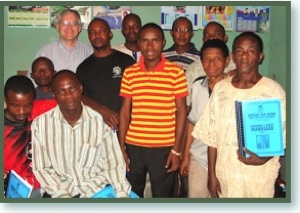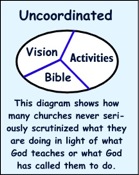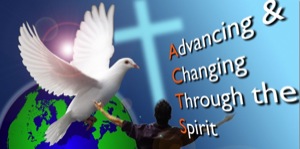
Book of ACTS
The Antioch Church: A Model for our Churches
The Bible Teacher's Commentary
Acts 13:1-3 (11:19-30)
Paul J. Bucknell
Purpose: A Bible exposition of A Diverse Church (Acts 13:1) illustrates the great diversity already part of the church even at that early stages (Part 3 of 5).They were not only different races, but cultures, classes and languages.
Introduction Acts 13:1-3 | Leadership Acts 13:1 | Diversity Acts 13:1 |
God-seeking Acts 13:2 | Mission-minded Acts 13:3
Video Podcast on Acts 13:1-3
B) A Diverse Church (Acts 13:1)
“Now there were at Antioch, in the church that was there, prophets and teachers: Barnabas, and Simeon who was called Niger, and Lucius of Cyrene, and Manaen who had been brought up with Herod the tetrarch, and Saul.” (Acts 13:1).
The diversity found in the Antioch church is very significant. There are barriers that are put up all around us. Without trying it is easy to offend others. A neighbor recently asked my son, “Are you allowed to play with the others around (referring to black children)?” My son wondered what did he mean. Of course they were able. But for a few years there were none around but this person thought we stayed away from them.
Misunderstandings easily form. We have a good number of black children playing over our yard now one might wonder whether we adopted some black children.
Diversity
Diversity is good, but it is not a goal in and of itself. The power of the church is that when the occasion warrants it, the church is not held back by racial, linguistic or class barriers and can manifest God’s mission of reaching the nations in one scene.
 Did you ever look at an old retreat picture? “This person was there. Oh yes, remember her?” You get to see in a glimpse the whole from the people present.
Did you ever look at an old retreat picture? “This person was there. Oh yes, remember her?” You get to see in a glimpse the whole from the people present.
Some church have gone astray by seeking diversity. Diversity means everything to them and so they feel they cannot exclude anyone from the Christian community. They take down racial boundaries, class barriers and doctrinal differences. Is this what happened at Antioch? Certainly not. The church’s purpose is not to make diversity but to live it out.
In other words, we should never allow racial, religious, cultural or linguistic barriers (or others - maybe I should include age or gender!) hinder us from reaching a particular group of people. And when people are joined together in faith in Christ, they become a community. The church should reflect the community they reach out to.
“Remember that you were at that time separate from Christ, excluded from the commonwealth of Israel, and strangers to the covenants of promise, having no hope and without God in the world. But now in Christ Jesus you who formerly were far off have been brought near by the blood of Christ. For He Himself is our peace, who made both groups into one, and broke down the barrier of the dividing wall” (Ephesians 2:12-14).
Are black or white churches wrong? No. Is it wrong to have a Chinese church in North America? Not necessarily. It is easier for one church to reach out to those from their own cultures. I met two elderly Chinese ladies when sharing the gospel the other week on the street. They told me, “If you were not speaking to us in Chinese, we would not understand anything you said.” They had just come from the Chinese church here.
So we have several principles here. We are open to embrace all who come to Christ. We can love anyone. We love all. And yet when reaching out, we are differently poised. We need to seek the Lord’s purpose for us and keep on track.
For the Antioch church, we see that the ministry leaders were very diverse. Barnabas was a strong Jewish teacher/evangelist sent from the Jerusalem church to care for the Antiochan church. Simeon was from Niger (country adjacent to African Niger River) – probably black.  Lucius of Cyrene was from North Africa, west of Egypt. Not only do we have Jews and Gentiles but those from different cultures, classes and linguistic backgrounds ministering together.
Lucius of Cyrene was from North Africa, west of Egypt. Not only do we have Jews and Gentiles but those from different cultures, classes and linguistic backgrounds ministering together.
I heard one brother say how he heard how one couple was burdened to start a real ethnic diverse church. In the south this meant a black and white church. He said that there are churches with black and white in them, but the leadership is only white. He wants a church that has both black and white leaders. This burden partially came from the vision of Acts 6:1-6 and here in Acts 13:1-3. Leadership needs to be shared when there is a diverse group being served.
If you are one who is offended by terms of black and white. Try not to be. They are general descriptive terms. When I go to Africa, the children call me ‘ebo.’ I wonder why? In Nigeria it means white.
In Taiwan they used to call all white people ‘bi-gok-lang.’ It means American. Even when my missionary companions were British or German, they were still called bi-gok-lang.
If you have experienced prejudice when growing up, it is harder not to be very sensitive to such terms. It is often not the terms but the hatred, bias and disdain passed on that is so distasteful. This is so unfortunate. Do forgive. Let us be the people of God that work together in love like Barnabas, Simeon, Lucius, Manaen and Saul.
Class difference
Manaen was the foster brother of Herod the Tetrarch that beheaded John the Baptist and participated in the trial of Jesus.
We must not only be willing to be with each other but serve with each other. This is the great example here in Antioch. They worked hand in hand. Praying. Evangelizing. Teaching. Fasting.
When we are all on our knees bowed before the Lord, we acknowledge one head, the Lord Jesus Christ. We are one body serving together. We can imagine that with him and Saul, who was highly educated, they were of those of a high class. Manaen was brought up in a palace while Saul was trained as a Hebrew rabbi.
They represent two extreme forms of higher class but in very different cultures. Saul was, of course, sought after by Barnabas, once sent from Jerusalem to Antioch (Acts 11:22-26). This action by Barnabas is the precise kind of love and attention needed in building up such teams.
From this peek into the church praying meeting many years ago, we realize that this church was far ahead of many of our churches today. It was diverse not only in congregation but in leadership. They served as one.
Application
- Am I prejudiced against any race, culture, language or class? I
- Have I been hurt by others due to my ethnicity? Have I fully forgiven them?
- Have we forsaken biblical principles to prioritize a false teaching of diversity?
- Unless we have dealt with poor experiences, they tend to negatively influence us. The Lord would have us forgive and reach out to our enemies.
Next -> C) A God-seeking Church (Acts 13:2)
BFF -> Moving our generation's heart and mind closer to the Lord through the powerful truths of God!





